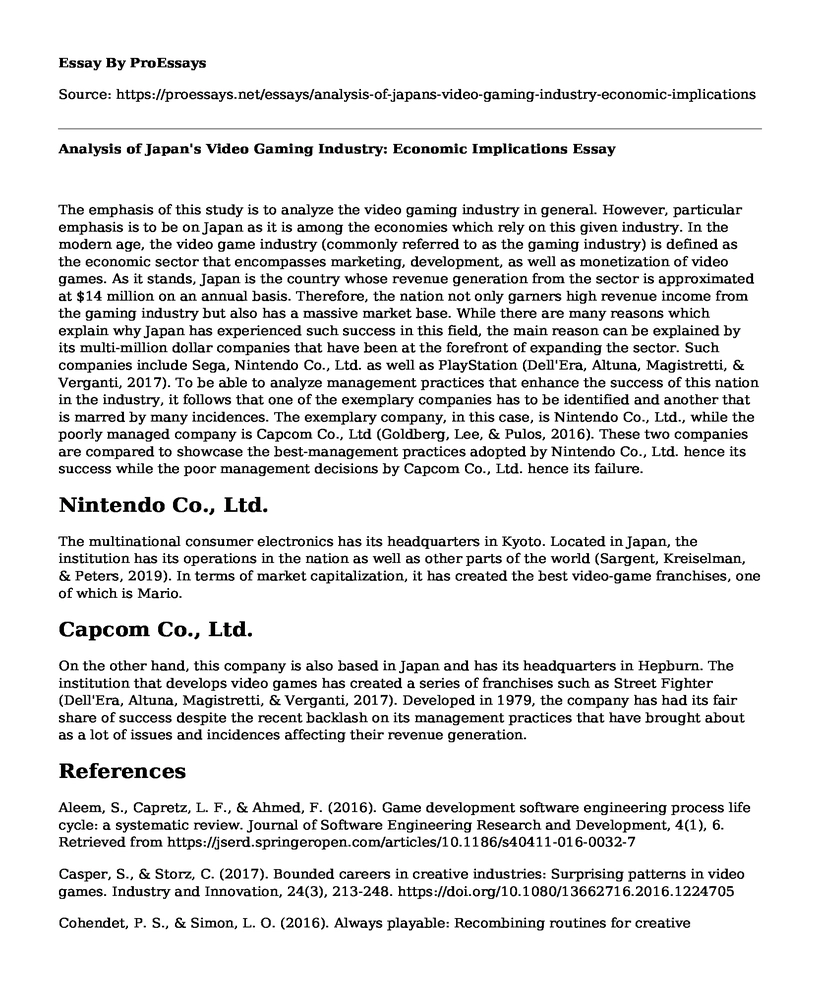The emphasis of this study is to analyze the video gaming industry in general. However, particular emphasis is to be on Japan as it is among the economies which rely on this given industry. In the modern age, the video game industry (commonly referred to as the gaming industry) is defined as the economic sector that encompasses marketing, development, as well as monetization of video games. As it stands, Japan is the country whose revenue generation from the sector is approximated at $14 million on an annual basis. Therefore, the nation not only garners high revenue income from the gaming industry but also has a massive market base. While there are many reasons which explain why Japan has experienced such success in this field, the main reason can be explained by its multi-million dollar companies that have been at the forefront of expanding the sector. Such companies include Sega, Nintendo Co., Ltd. as well as PlayStation (Dell'Era, Altuna, Magistretti, & Verganti, 2017). To be able to analyze management practices that enhance the success of this nation in the industry, it follows that one of the exemplary companies has to be identified and another that is marred by many incidences. The exemplary company, in this case, is Nintendo Co., Ltd., while the poorly managed company is Capcom Co., Ltd (Goldberg, Lee, & Pulos, 2016). These two companies are compared to showcase the best-management practices adopted by Nintendo Co., Ltd. hence its success while the poor management decisions by Capcom Co., Ltd. hence its failure.
Nintendo Co., Ltd.
The multinational consumer electronics has its headquarters in Kyoto. Located in Japan, the institution has its operations in the nation as well as other parts of the world (Sargent, Kreiselman, & Peters, 2019). In terms of market capitalization, it has created the best video-game franchises, one of which is Mario.
Capcom Co., Ltd.
On the other hand, this company is also based in Japan and has its headquarters in Hepburn. The institution that develops video games has created a series of franchises such as Street Fighter (Dell'Era, Altuna, Magistretti, & Verganti, 2017). Developed in 1979, the company has had its fair share of success despite the recent backlash on its management practices that have brought about as a lot of issues and incidences affecting their revenue generation.
References
Aleem, S., Capretz, L. F., & Ahmed, F. (2016). Game development software engineering process life cycle: a systematic review. Journal of Software Engineering Research and Development, 4(1), 6. Retrieved from https://jserd.springeropen.com/articles/10.1186/s40411-016-0032-7
Casper, S., & Storz, C. (2017). Bounded careers in creative industries: Surprising patterns in video games. Industry and Innovation, 24(3), 213-248. https://doi.org/10.1080/13662716.2016.1224705
Cohendet, P. S., & Simon, L. O. (2016). Always playable: Recombining routines for creative efficiency at Ubisoft Montreal's video game studio. Organization Science, 27(3), 614-632. https://doi.org/10.1287/orsc.2016.1062Dell'Era,
C., Altuna, N., Magistretti, S., & Verganti, R. (2017). Discovering quiescent meanings in technologies: exploring the design management practices that support the development of Technology Epiphanies. Technology Analysis & Strategic Management, 29(2), 149-166. https://doi.org/10.1080/09537325.2016.1210785
Dezaki, T., & Suzuki, Y. (2018). U.S. Patent Application No. 10/155,162. Retrieved from https://patents.google.com/patent/US10155162B2/en
Ernkvist, M. (2016). The role of dual institutional-and technological entrepreneurship in the formation of the Japanese social-game industry. In Global game industries and cultural policy (pp. 91-124). Palgrave Macmillan, Cham. DOI: 10.1007/978-3-319-40760-9_6
Goldberg, A., Lee, S. A., & Pulos, A. (2016). It's Dangerous to go Alone! Take this (New Technology): Nintendo's Impact on the Technological Landscape of the Video Gaming Industry. In Transnational Contexts of Development History, Sociality, and Society of Play (pp. 65-91). Palgrave Macmillan, Cham. DOI: 10.1007/978-3-319-43820-7_3
Johnson, I., Jackson, D., & Hanif, N. (2017). U.S. Patent No. 9,545,571. Washington, DC: U.S. Patent and Trademark Office. Retrieved from https://patents.google.com/patent/US9545571B2/en
Koizumi, M. (2016). Japanese Video Game Industry: History of Its Growth and Current State. In Transnational Contexts of Development History, Sociality, and Society of Play (pp. 13-64). Palgrave Macmillan, Cham. DOI: 10.1007/978-3-319-43820-7_2
Legault, M. J., & Weststar, J. (2015). The capacity for mobilization in project-based cultural work: A case of the video game industry. Canadian Journal of Communication, 40(2), 203-221. Retrieved from https://www.cjc-online.ca/index.php/journal/article/view/2805/2550Mc
Daniel, R., & Daer, A. (2016). Developer discourse: Exploring technical communication practices within video game development. Technical Communication Quarterly, 25(3), 155-166. DOI: 10.1080/10572252.2016.1180430
Peticca-Harris, A., Weststar, J., & McKenna, S. (2015). The perils of project-based work: Attempting resistance to extreme work practices in video game development. Organization, 22(4), 570-587. Retrieved from http://johanna-weststar.squarespace.com
Cite this page
Analysis of Japan's Video Gaming Industry: Economic Implications. (2023, Jan 29). Retrieved from https://proessays.net/essays/analysis-of-japans-video-gaming-industry-economic-implications
If you are the original author of this essay and no longer wish to have it published on the ProEssays website, please click below to request its removal:
- Effects of Job Stress, Attitude, and External Market on Employees' Turnover
- Should Mexico Be Blamed? Immigration in America and Its Policy Essay
- Research Paper on Syrian Refugees Crisis
- Sources and Uses of Cash Paper Example
- Essay Example on China & US: Peaceful Rise to Prosperity
- Essay Example on Post-Racial America? Uncovering Racism's Lingering Effects
- Essay Sample on Childish Gambino's This is America: A Commentary on American Society







